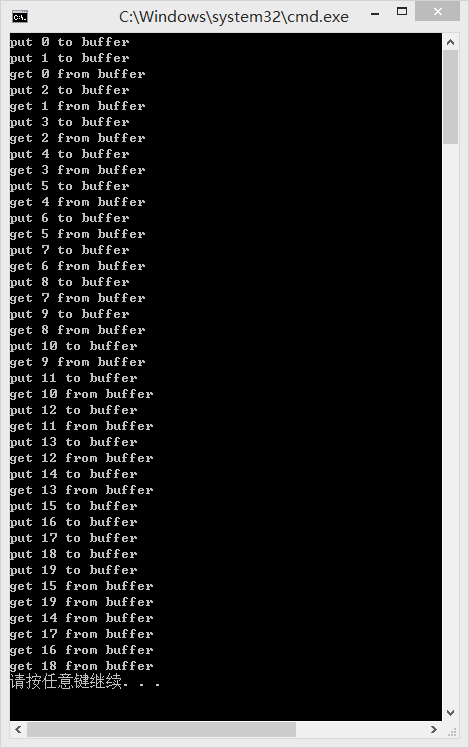条件变量实例:生产者-消费者模式的后进先出型(std::stack)缓冲区
2016-07-16 01:04
309 查看
综合应用boost::thread库(thread, mutex, condition_variable_any)实现的 生产者-消费者模式
后进先出型(std::stack)缓冲区
stack可以经过轻微修改使用队列替换。
运行结果为:

后进先出型(std::stack)缓冲区
stack可以经过轻微修改使用队列替换。
#include <boost/thread.hpp>
using namespace boost;
#include <stack>
#include <iostream>
using std::stack;
using std::cout;
using std::endl;
//生产者-消费者模式的后进先出型(std::stack)缓冲区
class Buffer
{
public:
//构造函数
Buffer(size_t n) :un_read(0), capacity(n){}
//写入数据x
void put(int x){
//局部域
{
mutex::scoped_lock lock(mu); //锁定互斥量
while (is_full()){
cond_put.wait(mu); //条件变量等待
}
stk.push(x); //写入数据
++un_read;
} //解锁互斥量
cond_get.notify_one(); //通知可以读取数据
}
//读取数据
void get(int *x){
{
mutex::scoped_lock lock(mu);
while (is_empty()){
cond_get.wait(mu);
}
*x = stk.top();
stk.pop();
--un_read;
}
cond_put.notify_one();
}
private:
//判断缓冲区是否满
bool is_full(){
return un_read == capacity;
}
//判断缓冲区是否为空
bool is_empty(){
return un_read == 0;
}
private:
mutex mu; //互斥量,配合条件变量使用
condition_variable_any cond_put; //写入条件变量
condition_variable_any cond_get; //读取条件变量
stack<int> stk; //缓冲区对象
int un_read;
int capacity;
};
Buffer buf(5); //定义一个缓冲区对象
mutex io_mu_; //定义一个输出互斥量
//生产者,n个
void producer(int n)
{
for (int i = 0; i < n; i++){
//输出信息
{
mutex::scoped_lock lock(io_mu_);
cout << "put " << i <<" to buffer"<< endl;
}
buf.put(i); //写入数据
}
}
//消费者
void consumer(int n)
{
int result(0);
for (int i = 0; i < n; i++){
{
buf.get(&result); //读取数据
mutex::scoped_lock lock(io_mu_);
cout << "get " << result << " from buffer" << endl;
}
}
}
void producer_consumer_test()
{
thread t_producer(producer, 20);
thread t_consumer1(consumer, 10);
thread t_consumer2(consumer, 10);
t_producer.join();
t_consumer1.join();
t_consumer2.join();
}运行结果为:

相关文章推荐
- boost相关小知识(长期顶置更新)
- C++单元测试:boost.test
- boost asio学习笔记 [1] - 同步通讯
- boost_asio学习笔记[2] - 客户端异步通讯
- boost::flat_map性能测试
- Ubuntu下如何安装boost?
- How to get a boost::shared_ptr from this
- boost 库 enable_shared_from_this 实现原理分析
- boost bind使用指南
- 最常用的两种C++序列化方案的使用心得
- 使用boost进行CRC64计算
- [网络开发]boost::asio简介
- Windows下如何编译使用boost?
- Boost库学习(0)
- Boost库学习(1)log和unittest
- Boost库学习(2)thread 1
- Boost库学习(3)thread 2
- Boost库学习(4)thread 3
- Boost库学习(6)filesystem
- Boost库学习(7)regex
